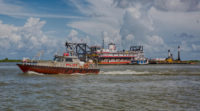Much new construction along the Mississippi coast now was built with 1969�s Hurricane Camille in mind. At the time, the storm was thought to be the worst destructive force that could possibly hit the region. But Hurricane Katrina came ashore with a broader, higher storm surge, up to 30 ft high. As a result, homes and other structures did not simply have trees thrown through them. They were washed clean from their foundations.
| Regional wastewater treatment plant in Waveland, Miss., faces major repairs to piping and other infrastructure.(Photo: E. Michael Powers for ENR) |
The massive influx of water destroyed much of the region�s critical infrastructure. Some cities have running water but residents have been advised to boil it because of decontamination risks. Most of the region does not have functional sewer systems. The U. S. Army Corps of Engineers has stepped in to help the battered, resource-strapped municipalities fix broken wastewater treatment plants. At the Southern Regional Wastewater Management District's treatment plant in Waveland, Corps members were on scene leading an effort to repair its damaged portions.
The storm surge dissipated to approximately 8 ft upon reaching the plant, allowing it to survive structurally but ruining much of its equipment. �There�s nothing really running. Anything electronic is probably going to have to be replaced,� says William Demers, a Corps maintenance mechanic, who leads the repair team. Even functional wiring will have to be replaced because of gradual salt-induced decay, he says.
A parts shortage is hindering the repair effort at the plant. No one can deliver needed parts, so a worker had to be sent to Mobile, Ala., to procure new electric motors, he says. A smattering of small specialty contractors are helping to assess damage and make repairs. Plant generators work but water overtopped the tanks, requiring replacements. Demers also is unsure of the extent of plant damage, time needed to fix it, cost and repair funding sources.
| Hurricane Katrina's storm surge, up to 30 ft, knocked out. (Photo: E. Michael Powers for ENR) |
Lt. Col. Mike Windham, construction and facility management officer for the Mississippi National Guard, is helping to coordinate efforts of the Corps, the Federal Emergency Management Agency, and Mississippi's own emergency agency. �I�m glad to see that the army jumped out here without an order. I�ve been authorized to tell you to do whatever it takes,� he says to Demers. �We�ll take care of the paperwork later, don�t worry about that. We�ve got to get these city workers to where they can take care of their families.�
Concerns extend past those for the workers who must continue to work despite having their homes destroyed. �We�ve got to get this sewage plant on or we�re going to have a secondary problem when the water starts flowing," says Windham, who delivered the blanket order on his way to meet with Waveland municipal officials to promise the military�s full support for repairing critical utilities.
Suspended bureaucratic regulation is not limited to the town of Waveland. �We�re taking this approach all along the Gulf Coast,� says Windham. Corps attention is also focused on Gulfport wastewater and water treatment systems along with those in nearby Hancock County and Harrison County, whose populations and Katrina impacts are greatest. �We�re driving hard down here because this is where we�re really hurting,� says Windham.
Reaching the more ravaged areas is a challenge due to massive road damage. Bridges on I-10, I-110, and U.S. 90 all sustained damage, ranging from span closure to complete obliteration. Most roads exposed to the Gulf are impassable after the storm surge sucked the earth from beneath them. The railroad running along the coast is also impassable. Tracks were ripped from the bridge across the St. Louis Bay and lay mangled.
The Corps has backhoes clearing debris fields far enough from the road so that power trucks can begin to rebuild the local electricity grid. The agency is also clearing the parking lot of an amusement park so that FEMA could eventually use it as a local base of operations in Waveland. A lot also will house trailers for temporary housing, says Corps spokesman Frank Worley.
The Corps took the lead on a variety of humanitarian efforts, he says, such as delivering ice, water, and food to the people of the Mississippi Coast, but has since handed the task off to FEMA, the Red Cross and other humanitarian organizations. It has since moved on to other humanitarian efforts with "Operation Blue Roof," in which local contractors are installing for free, high quality temporary roofs for permanent area residents.
|

